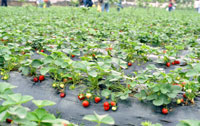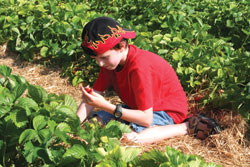
Features
Production
Research
Production systems matter in PYO operations
April 24, 2008 By Fruit & Vegetable
It would appear that how farmers
grow berries can be just as important to pick-your-own strawberry
consumers as the quality of the fruit produced.
 |
| Consumers surveyed in the first year of the study preferred picking fruit from the plasticulture system, where strawberries are grown on raised beds using black plastic mulch and a trickle irrigation system. |
It would appear that how farmers grow berries can be just as important to pick-your-own strawberry consumers as the quality of the fruit produced.
A team of researchers from the University of Maryland, Utah State University, and the U.S. Department of Agriculture compared three different strawberry production systems over a two-year period (2003 and 2004) to determine which system pick-your-own strawberry consumers preferred. Researchers also examined each production system to compare the quality of strawberries produced and attempted to determine how consumer preference affected the price customers would pay for fresh berries.
Matthew Stevens, a graduate student at the University of Maryland, undertook the research project as part of his master’s thesis. Stevens reported that consumers surveyed in the first year of his study preferred picking fruit from the cold-climate plasticulture system, where strawberries are grown on raised beds using black plastic mulch and a trickle irrigation system.
But during the second year of the study, Stevens’ team found that consumers surveyed preferred PYO strawberries grown in the advanced matted row system, which features raised beds covered with a cover crop mulch instead of plastic mulch and a subsurface drip irrigation system.
 |
| During the second year of the study, consumers surveyed preferred PYO strawberries grown in the advanced matted row system, which features raised beds covered with a mulch (straw) instead of plastic mulch and a subsurface drip irrigation system. |
“This seems to suggest that the cold-climate plasticulture system, typically an annual production system, is not ideal for perennial production, but would be popular as an annual system,” says Stevens. “The conventional matted row system, most commonly used in colder production regions, was the least popular system in the first year and was ranked between the advanced matted row and cold-climate plasticulture system in the second year. Most consumers (63 per cent) indicated they would be willing to pay more to pick fruit from their favourite system.
“We also found that, among fruit quality characteristics tested, only firmness differed among the systems, with fruit from the cold-climate plasticulture being slightly softer than fruit from the other two systems.”
According to Stevens, the research study will provide growers with a clear comparison of how different strawberry production systems affect customers’ perceptions of pick-your-own experiences.
“As growers consider shifting from the conventional matted row system to modern systems, this research will give them an idea of how customers may react to such a change,” he says. “Growers can use this information, along with information on economics and environmental impacts of the systems, to make an informed decision on which system would be best to use on their farm.”
Print this page